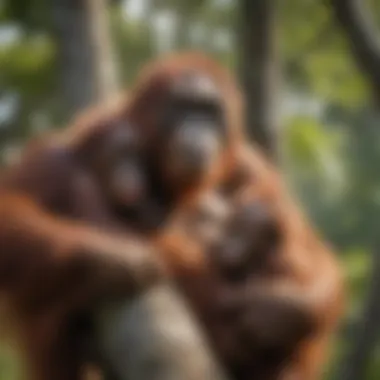Exploring the Critical Status of Orangutans: An In-Depth Analysis


Nature Topic Overview
Orangutans, the majestic and highly intelligent primates, have been facing critical challenges leading to their endangered status. The impact of habitat loss and poaching is significant, drawing attention to the urgent need for conservation efforts to protect these fascinating creatures.
Fun Facts and Trivia
Engage young readers with intriguing facts about orangutans to enhance their learning experience. Did you know that orangutans are the largest tree-dwelling animals on Earth? Their arm span can reach up to 7 feet, enabling them to swing effortlessly through the lush rainforest canopy. Visual aids and interactive elements can further captivate children's curiosity and deepen their knowledge.
Wildlife Explorations
Delve into the diverse species related to orangutans, such as the Bornean and Sumatran orangutans, each with unique characteristics and adaptation to their habitats. Explore the rich ecosystem they inhabit, including rare plants and animals that coexist in harmony. Interactive features like quizzes and puzzles can make learning about orangutans and their surroundings both entertaining and educational.
Environmental Awareness
Understand the critical importance of conservation and sustainability practices to safeguard orangutans and their habitat. Children can learn valuable tips on how they can contribute to protecting nature, from reducing plastic waste to supporting ethical eco-tourism initiatives. Instilling environmental consciousness early on fosters a sense of responsibility towards preserving our planet for future generations.
DIY Nature Activities
Encourage hands-on exploration with engaging activities for children to try at home. From creating nature-inspired crafts using recycled materials to embarking on outdoor adventures to observe wildlife, there are endless opportunities to connect with nature. Step-by-step guides empower kids to unleash their creativity and develop a deeper appreciation for the natural world around them.
Understanding Orangutans
Orangutans are remarkable primates native to the rainforests of Southeast Asia, known for their distinctive features and fascinating behaviors. Understanding orangutans plays a crucial role in conservation efforts and raising awareness about the challenges they face. By delving into their physical characteristics, behaviors, and habitats, we can grasp the significance of protecting these intelligent creatures.
Physical Characteristics of Orangutans
Distinctive Features
Orangutans possess unique red-brown shaggy fur, long arms, and a bulky body shape. Their most distinctive feature is their highly dexterous hands, equipped with opposable thumbs similar to human hands. This adaptation allows them to navigate their arboreal environment with exceptional agility, showcasing their evolutionary prowess in surviving in the dense rainforests.
Size and Weight
Orangutans exhibit sexual dimorphism, with males being significantly larger than females. Adult males can weigh up to 200 pounds and reach heights of around 5 feet, while females are about half their size. This size difference reflects their solitary lifestyles and dietary needs, emphasizing the importance of understanding their unique anatomical variations.
Adaptations for Tree-dwelling Life
Adapted for a primarily arboreal existence, orangutans possess strong arm muscles that aid in swinging from tree to tree. Their long, powerful arms enable them to grasp branches firmly, supporting their weight as they navigate the forest canopy. Furthermore, their broad, flexible hands and feet with curved fingers and toes provide excellent grip and balance, essential for survival in their tree-dwelling habitat.


Orangutan Species
Bornean Orangutans
Bornean orangutans, endemic to the island of Borneo, are characterized by their broader faces and darker fur compared to other orangutan species. Their adaptability to diverse forest habitats reflects their resilience in the face of environmental challenges, making them a focal point in conservation strategies targeting orangutan species.
Sumatran Orangutans
Sumatran orangutans, found exclusively on the island of Sumatra, possess lighter, longer fur and slimmer bodies compared to their Bornean counterparts. Their distinct physical features and genetic differences underscore the importance of species-specific conservation efforts to safeguard their dwindling populations.
Tapanuli Orangutans
Tapanuli orangutans, the rarest orangutan species inhabiting the Batang Toru forests of Sumatra, exhibit unique genetic traits that set them apart from Bornean and Sumatran orangutans. With only a few hundred individuals remaining, Tapanuli orangutans face heightened threats of extinction, emphasizing the critical need for conservation measures tailored to their specific habitat and demographic challenges.
Orangutans in Peril
Orangutans in Peril is a crucial section in this article, shedding light on the imminent threats faced by these majestic creatures. The rapid habitat loss, primarily due to deforestation, poses a severe risk to orangutan populations. Understanding the magnitude of this issue is vital in orchestrating effective conservation strategies. By comprehensively delving into the factors contributing to their endangerment, we can better grasp the urgency of safeguarding orangutans.
Habitat Loss
Deforestation
Deforestation stands out as a primary catalyst in the decline of orangutan habitats. The extensive clearing of forests for agricultural purposes drastically reduces the available living space for these primates. This detrimental practice not only diminishes the orangutans' natural environment but also disrupts the delicate balance of the ecosystem they rely on. Examining the profound impact of deforestation is crucial in comprehending the gravity of the situation.
Palm Oil Plantations
The establishment of vast palm oil plantations presents a significant threat to orangutan habitats. The conversion of lush forests into monoculture plantations not only erases vital biodiversity hotspots but also displaces indigenous species like orangutans. Unraveling the link between palm oil production and habitat destruction is pivotal to addressing the conservation challenges confronting orangutans.
Mining Activities
Mining activities contribute to the degradation of orangutan habitats through pollution, habitat destruction, and ecosystem disturbance. The excavation processes associated with mining projects have far-reaching implications on the fragile ecosystems where orangutans reside. Analyzing the adverse effects of mining on orangutan populations is essential in formulating sustainable solutions to mitigate habitat loss.
Impact of Illegal Poaching
Demand for Orangutan Parts
The illegal trade in orangutan parts is fueled by a relentless demand for exotic wildlife products. The poaching crisis targeting orangutans for their body parts jeopardizes the survival of these primates. Exploring the root causes of this demand and the repercussions on orangutan populations is crucial in combatting the illicit trade and protecting these endangered beings.
Bushmeat Trade


The bushmeat trade represents a significant threat to orangutans, driven by the consumption of their meat in certain regions. The unsustainable hunting of orangutans for bushmeat not only decimates their numbers but also disrupts the ecological balance of their habitats. Unveiling the complexities of the bushmeat trade sheds light on the challenges faced in conserving orangutan populations.
Pet Trade
The illicit pet trade poses a grave threat to orangutans, capturing individuals for commercial exploitation as exotic pets. The illegal trafficking of orangutans not only separates young primates from their mothers but also subjects them to inadequate care and living conditions. Examining the detrimental effects of the pet trade on orangutans is imperative in addressing this form of exploitation and protecting the welfare of these sentient beings.
Conservation Efforts
In this crucial section of our comprehensive overview on the endangered orangutans, we shed light on the paramount importance of conservation efforts. Understanding the urgent need to protect these intelligent primates involves delving into various specific elements such as creating protected reserves and sanctuaries, conducting community outreach programs, and fostering international collaborations. Conservation efforts not only aim to safeguard orangutans in their natural habitat but also address the underlying causes contributing to their endangered status. Exploring these efforts allows us to appreciate the multifaceted strategies required to ensure the survival and well-being of orangutans in the face of mounting threats.
Protected Reserves and Sanctuaries
Sepilok Orangutan Rehabilitation Centre
The Sepilok Orangutan Rehabilitation Centre stands as a beacon of hope amidst the challenges faced by orangutans. This sanctuary plays a pivotal role in providing a safe haven for orphaned and injured orangutans, aiding in their rehabilitation for eventual release back into the wild. The key characteristic of the Sepilok Centre lies in its dedication to nurturing orphaned orangutans, teaching them vital survival skills, and reintegrating them into their natural environment. Its unique feature includes the provision of a semi-wild environment that facilities the learning and adaptation process for these primates, preparing them for a sustainable life in the wild. While Sepilok's efforts are commendable, challenges such as limited resources and increasing human encroachment remain hurdles that require continuous attention and support.
Camp Leakey
Camp Leakey stands as a pioneer in orangutan conservation, renowned for its groundbreaking research and rehabilitation efforts. This camp's key characteristic lies in its long-standing commitment to studying orangutan behavior, habitat dynamics, and social structures, contributing valuable insights to the broader conservation community. Its unique feature includes the development of innovative enrichment programs that simulate natural foraging experiences for rehabilitated orangutans, fostering their physical and mental well-being. Despite its significant contributions, Camp Leakey grapples with funding constraints and the ongoing challenge of balancing research priorities with hands-on conservation efforts.
Gunung Palung National Park
Nestled within the rich biodiversity of Borneo, Gunung Palung National Park plays a crucial role in safeguarding the natural habitat of orangutans. The key characteristic of this park is its extensive rainforest cover, providing a pristine environment for orangutans to thrive and flourish. Gunung Palung's unique feature includes its focus on community engagement and sustainable forest management practices, ensuring the coexistence of wildlife and local populations. While the park offers a haven for orangutans, threats such as illegal logging and deforestation pose imminent risks that necessitate vigilant protection measures to secure the park's ecological integrity.
Community Outreach Programs
Education Initiatives
Education initiatives form a cornerstone of orangutan conservation, aiming to raise awareness and instill a sense of environmental stewardship among local communities and global audiences alike. The key characteristic of education initiatives lies in their capacity to empower individuals with knowledge about orangutans' ecological importance, threats they face, and ways to contribute to their protection. This unique feature involves interactive learning tools, outreach programs, and advocacy campaigns that engage diverse audiences in conservation efforts. While education initiatives have shown promising results in fostering public support for orangutan conservation, sustained funding and consistent outreach remain critical for ensuring their long-term effectiveness.
Sustainable Livelihood Projects
Sustainable livelihood projects offer a holistic approach to conservation by addressing the root causes of habitat destruction and poaching through community empowerment and economic alternatives. The key characteristic of these projects lies in their focus on providing local communities with sustainable income opportunities that reduce their dependency on activities harmful to orangutans' natural habitats. Their unique feature includes promoting eco-friendly livelihood practices such as agroforestry, eco-tourism, and handicraft production, fostering economic resilience while preserving environmental resources. Despite the benefits of sustainable livelihood projects, challenges such as market access and scalability warrant continuous evaluation and adaptation to ensure their lasting impact on orangutan conservation.
Anti-Poaching Campaigns
Anti-poaching campaigns serve as a frontline defense against illegal wildlife trade and hunting activities threatening orangutans' survival in the wild. The key characteristic of these campaigns lies in their proactive measures to deter poachers, intercept illegal wildlife products, and enforce wildlife protection laws through collaboration with law enforcement agencies. Their unique feature includes community-driven surveillance networks, technology-based monitoring systems, and intelligence gathering efforts that bolster anti-poaching initiatives' effectiveness. While anti-poaching campaigns have successfully reduced poaching rates in certain areas, ongoing vigilance and support from local communities are imperative to combatting this persistent threat to orangutans.


International Collaborations
Partnerships with Conservation Organizations
Partnerships with conservation organizations foster a collaborative ecosystem of knowledge sharing, resource pooling, and coordinated action to protect orangutan populations across their range countries. The key characteristic of these partnerships lies in their ability to leverage expertise, funds, and networks to implement conservation projects that address orangutans' diverse conservation needs. Their unique feature includes the development of joint research programs, capacity-building workshops, and advocacy campaigns that amplify conservation impacts and raise global awareness about orangutan conservation. While partnerships with conservation organizations have yielded significant conservation gains, maintaining transparent communication, mutual respect, and shared responsibilities are essential for sustaining these collaborative efforts in the long run.
Research Initiatives
Research initiatives play a pivotal role in advancing our understanding of orangutan ecology, behavior, and population dynamics, informing evidence-based conservation strategies and wildlife management practices. The key characteristic of research initiatives lies in their systematic approach to collecting field data, conducting genetic analyses, and monitoring orangutan populations to support conservation decision-making. Their unique feature includes the integration of cutting-edge technologies, such as drone surveys, camera trapping, and geographic information systems, to enhance data accuracy and scientific rigor in orangutan research. While research initiatives have expanded our knowledge base on orangutans, securing long-term funding, promoting interdisciplinary collaboration, and sharing research findings with diverse stakeholders remain essential for maximizing their conservation impact.
Advocacy Campaigns
Advocacy campaigns mobilize public support, political will, and corporate engagement to drive policy changes, conservation action, and public awareness for orangutan protection. The key characteristic of advocacy campaigns lies in their ability to unify diverse stakeholders, amplify conservation messages, and mobilize grassroots movements to champion orangutan conservation causes. Their unique feature includes the use of multimedia campaigns, social media platforms, and public events to reach wider audiences and exert collective pressure on decision-makers for impactful change. While advocacy campaigns have catalyzed significant policy reforms and industry commitments towards orangutan conservation, sustaining momentum, fostering intersectoral partnerships, and adapting advocacy strategies to evolving challenges are crucial for achieving lasting conservation outcomes.
Future Prospects for Orangutans
In this section, we delve into the Future Prospects for Orangutans, shining a light on what lies ahead for these incredible creatures. It is crucial to consider the trajectory of orangutans' survival and well-being to ensure their continued existence on this planet. Understanding the challenges and opportunities ahead is paramount in making informed decisions for their conservation and protection.
Challenges Ahead:
Climate Change Effects
Climate change effects pose a significant threat to orangutans and their habitats. The increasing temperatures, altered precipitation patterns, and natural disasters disrupt the fragile ecosystems where orangutans reside, leading to food scarcity and habitat degradation. This section discusses the specific repercussions of climate change on orangutans and emphasizes the urgent need for proactive measures to mitigate its impact.
Continued Deforestation
Continued deforestation remains a pressing issue contributing to the decline of orangutan populations. The relentless clearing of forests for agricultural expansion, logging, and human settlements destroys crucial orangutan habitats, fragmenting their populations and reducing genetic diversity. Addressing the root causes and consequences of continued deforestation is essential for safeguarding the future of orangutans.
Global Economic Pressures
Global economic pressures, driven by demands for natural resources and unsustainable development practices, further exacerbate the challenges faced by orangutans. The prioritization of profit over environmental conservation leads to exploitative practices that harm orangutan habitats and populations. This segment explores the intricate interplay between economic interests and conservation efforts, underscoring the need for balanced and sustainable approaches to protect orangutans.
Hope for the Species:
Conservation Innovations
Innovative conservation strategies offer a beacon of hope for orangutans, presenting novel ways to address conservation challenges effectively. From advanced monitoring technologies to community-based conservation initiatives, conservation innovations play a vital role in enhancing orangutan protection efforts. This part highlights the significance of embracing cutting-edge solutions to conserve orangutans and their habitats effectively.
Public Awareness Campaigns
Public awareness campaigns serve as powerful tools in raising consciousness about orangutan conservation issues and garnering public support for conservation initiatives. By educating and engaging diverse audiences, these campaigns amplify the message of orangutan conservation, fostering a culture of empathy and responsibility towards nature. This segment underscores the importance of public engagement in shaping positive outcomes for orangutans.
Youth Engagement Programs
Empowering the younger generation through targeted youth engagement programs cultivates a sense of environmental stewardship and instills a passion for wildlife conservation. By involving youths in orangutan conservation activities, these programs nurture a sustainable conservation ethic and encourage active participation in safeguarding orangutans' futures. Exploring the unique benefits of youth engagement programs, this section showcases the transformative impact of investing in the environmental awareness and activism of tomorrow's leaders.







